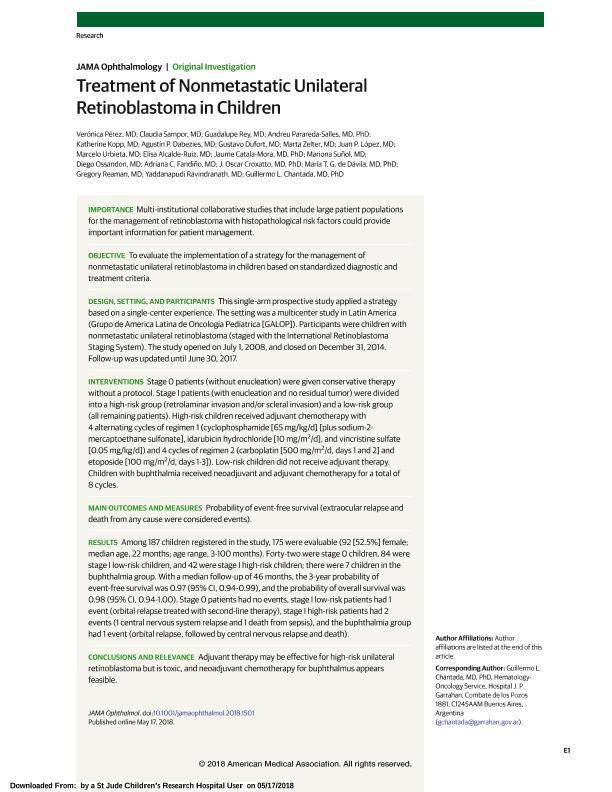Artículo
Treatment of nonmetastatic unilateral retinoblastoma in children
Pérez, Verónica; Sampor, Claudia; Rey, Guadalupe; Parareda Salles, Andreu; Kopp, Katherine; Dabezies, Agustín P.; Dufort, Gustavo; Zelter, Marta; López, Juan P.; Urbieta, Marcelo; Alcalde Ruiz, Elisa; Catala Mora, Jaume; Suñol, Mariona; Ossandon, Diego; Fandiño, Adriana Cristina; Croxatto, Juan Oscar ; De Dávila, María T. G.; Reaman, Gregory; Ravindranath, Yaddanapudi; Chantada, Guillermo Luis
; De Dávila, María T. G.; Reaman, Gregory; Ravindranath, Yaddanapudi; Chantada, Guillermo Luis
 ; De Dávila, María T. G.; Reaman, Gregory; Ravindranath, Yaddanapudi; Chantada, Guillermo Luis
; De Dávila, María T. G.; Reaman, Gregory; Ravindranath, Yaddanapudi; Chantada, Guillermo Luis
Fecha de publicación:
07/2018
Editorial:
American Medical Association
Revista:
JAMA Ophthalmology
ISSN:
2168-6165
Idioma:
Inglés
Tipo de recurso:
Artículo publicado
Clasificación temática:
Resumen
IMPORTANCE: Multi-institutional collaborative studies that include large patient populations for the management of retinoblastoma with histopathological risk factors could provide important information for patient management. OBJECTIVE: To evaluate the implementation of a strategy for the management of nonmetastatic unilateral retinoblastoma in children based on standardized diagnostic and treatment criteria. DESIGN, SETTING, AND PARTICIPANTS: This single-arm prospective study applied a strategy based on a single-center experience. The setting was a multicenter study in Latin America (Grupo de America Latina de Oncologia Pediatrica [GALOP]). Participants were children with nonmetastatic unilateral retinoblastoma (staged with the International Retinoblastoma Staging System). The study opened on July 1, 2008, and closed on December 31, 2014. Follow-up was updated until June 30, 2017. INTERVENTIONS: Stage 0 patients (without enucleation) were given conservative therapy without a protocol. Stage I patients (with enucleation and no residual tumor) were divided into a high-risk group (retrolaminar invasion and/or scleral invasion) and a low-risk group (all remaining patients). High-risk children received adjuvant chemotherapy with 4 alternating cycles of regimen 1 (cyclophosphamide [65mg/kg/d] [plus sodium-2-mercaptoethane sulfonate], idarubicin hydrochloride [10mg/m2/d], and vincristine sulfate [0.05mg/kg/d]) and 4 cycles of regimen 2 (carboplatin [500mg/m2/d, days 1 and 2] and etoposide [100mg/m2/d, days 1-3]). Low-risk children did not receive adjuvant therapy. Children with buphthalmia received neoadjuvant and adjuvant chemotherapy for a total of 8 cycles. MAIN OUTCOMES AND MEASURES: Probability of event-free survival (extraocular relapse and death from any cause were considered events). RESULTS: Among 187 children registered in the study, 175 were evaluable (92 [52.5%] female; median age, 22 months; age range, 3-100 months). Forty-two were stage 0 children, 84 were stage I low-risk children, and 42 were stage I high-risk children; there were 7 children in the buphthalmia group. With a median follow-up of 46 months, the 3-year probability of event-free survival was 0.97 (95%CI, 0.94-0.99), and the probability of overall survival was 0.98 (95%CI, 0.94-1.00). Stage 0 patients had no events, stage I low-risk patients had 1 event (orbital relapse treated with second-line therapy), stage I high-risk patients had 2 events (1 central nervous system relapse and 1 death from sepsis), and the buphthalmia group had 1 event (orbital relapse, followed by central nervous relapse and death). CONCLUSIONS AND RELEVANCE: Adjuvant therapymay be effective for high-risk unilateral retinoblastoma but is toxic, and neoadjuvant chemotherapy for buphthalmus appears feasible.
Palabras clave:
Retinoblastoma
,
Chemotherapy
Archivos asociados
Licencia
Identificadores
Colecciones
Articulos(SEDE CENTRAL)
Articulos de SEDE CENTRAL
Articulos de SEDE CENTRAL
Citación
Pérez, Verónica; Sampor, Claudia; Rey, Guadalupe; Parareda Salles, Andreu; Kopp, Katherine; et al.; Treatment of nonmetastatic unilateral retinoblastoma in children; American Medical Association; JAMA Ophthalmology; 136; 7; 7-2018; 747-752
Compartir
Altmétricas



